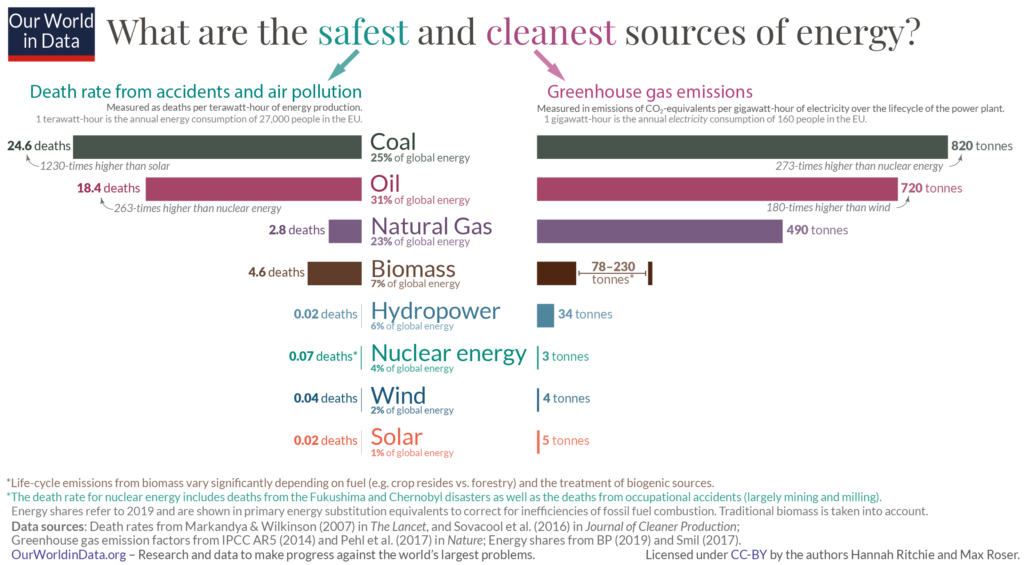By Andreas Bock Michelsen
This is the second part in a series on the fundamental physical concepts involved in talking about energy.
Part One: Reclaiming the Air Through Sustainable Aviation
Nuclear energy is almost universally feared and reviled, and not without reason. The disaster at Chernobyl in 1986 stands as an eternal reminder of the disastrous potential of the technology. The 2011 accident in Fukushima shows that even today a nuclear reactor is an inherently dangerous thing, which must be treated with caution and respect to avoid terrible consequences for the surrounding communities and ecosystems. Even when reactors run without issues, they produce poisonous waste, which takes thousands, if not millions, of years to decay. It may be no surprise, then, that global nuclear energy production has stagnated, and that strong opposition to the technology remains in Europe in particular. One example is Germany, where almost 12% of the electricity came from nuclear power in the 90’s, but where all nuclear facilities will be decommissioned by 2022. Another example is the recent election in Greenland, where the popular resistance against the potential mining of fuel for nuclear reactors was a key element in the fall of the sitting, pro-mining government.
And yet, China has doubled its nuclear capacity since 2014, climate scientists have called for an increase in nuclear power, while the Intergovernmental Panel on Climate Change identifies increased production of nuclear energy as a key element in avoiding global warning. Why is such an obviously dangerous and polluting energy source considered an important element of the green energy transition? The key idea is that while renewable energy is preferable to nuclear energy, we should use nuclear energy in conjunction with renewable energy to phase out fossil fuels as soon as possible. To understand this argument better, we need to explore how nuclear energy compares to other energy sources, both renewable and fossil, with regards to safety, environmental impact, and practicality. But first a warning: many of the numbers presented are estimates and they can vary quite a bit depending on the underlying assumptions, so consider them representations of overall trends.
While nuclear energy is undeniably dangerous, it turns out to be far safer than fossil fuel. To see this, we can consider how many people have died per energy unit produced, or more specifically we can compare the deaths per terawatt-hour (TWh) for different energy sources. The numbers below include premature deaths due to short- and long-term consequences of occupational accidents (e.g. during mining), civilian accidents (e.g. nuclear meltdown and following cancer cases) as well as consequences of air pollution. While these are grim numbers to compare, they are also very revealing: Despite the large disasters, nuclear energy on average leads to only 0.07 deaths per TWh, counting both the accidents at Chernobyl and Fukushima, see the figure below. While any death is one too many, in comparison coal and oil production lead to 24.6 and 18.4 deaths per TWh, respectively. To put these numbers into perspective we can consider a European town of about 187,000 people, which would consume one TWh of electricity per year. If that electricity came from coal, on average this production would cause around 25 premature deaths per year (around 18 for oil), but if it came from nuclear power, on average it would cause one death every 14 years. In this sense, nuclear energy is several orders of magnitude safer than fossil fuels and could even prevent a significant number of deaths by replacing fossil fuels.

Secondly, nuclear energy could also be considered as having a low environmental impact. While we wait for renewable energy sources to be able to cover the global supply of power, the low carbon dioxide emissions from nuclear power plants (see Fig. 1) means we must consider which of the following we prefer: On one hand, the air pollution from fossil fuels or on the other hand the radioactive waste from nuclear power. Air pollution leads to short-term premature deaths and long-term climate change, radioactive waste remains dangerous for immense lengths of time with no known practical means of neutralization other than storing the waste underground. Both outcomes are very undesirable, but at this time global climate change is arguably the more critical issue. Thus, producing radioactive waste instead of greenhouse gas emissions is a tolerable trade-off.
Of course, for an increase in nuclear electricity generation to make any sense, it must have advantages over not only fossil fuels but also renewable energy. As we will see, nuclear energy shares some of the key benefits that fossil fuels have over renewable energy, which makes it simpler in the short term to replace fossil fuels with nuclear energy. The first major benefit over renewables is that modern nuclear reactors are fully able to follow the load of the electrical grid, i.e. the power output can be adjusted up and down to follow the electricity demand. This addresses the classical problem of “where does the energy come from when the sun is not shining, and the wind is not blowing?” Nuclear energy deals with the problem with currently available, well-tested and scalable technology, while other solutions such as energy storage still requires radical advances.
The second benefit is about energy density. As explained in the previous blog post, an important benefit of using fossil fuels for transport is that they have high energy density in terms of energy produced per kg, as well as per m3. Nuclear fuel is millions of times denser than coal and oil, meaning that a nuclear airplane would require only a few grams of nuclear fuel. Yet, that would require installing a nuclear reactor aboard the plane, which would be extremely impractical. However, nuclear energy is also the densest type of energy in terms of terawatt-hours per km2. The total land area required to meet our energy demand is an important characteristic, since that land cannot be used e.g. for absorbing carbon dioxide into forests or for feeding our growing population. Nuclear energy has the smallest footprint of all energy types, being one to two orders of magnitude smaller than the footprints of wind and solar energy. In other words, for nuclear power plants to produce 1 TWh over their total lifespan, which is what our European town of 187.000 people consume in a year, it would require a total of around 0.32 km2 of land from the start of mining to the end of decommissioning the plants. Onshore windfarms would require around 1.1 km2 of land, almost 3.5 times more, while solar cells about 20 km2 of land, more than 62 times more.
A fundamental caveat is that nuclear energy depends on rare-earth elements like uranium for fuel, of which there are only a finite amount on Earth. It is estimated that at current levels of uranium consumption, we have around 230 years of global supply available using those technologies which are currently economically feasible. In the very long run, nuclear energy would require novel technologies such as seawater uranium extraction which would lead to dramatically increased global supplies lasting as long as the lifetime of our sun. However, with global energy consumption continuing to increase at an inexorable pace, nuclear energy also offers key short-term benefits: a commercially available and well-tested technology with negligible greenhouse gas emissions which could replace fossil fuels while renewable energy catches up.
Finally, we have the issue of price. While cheaper and more efficient designs are being developed, current nuclear reactors are expensive to maintain, and nuclear energy can be very expensive compared to other sources. However, a report commissioned by the UK government indicates that the price can be driven down significantly through efficient yet safe design choices. According to this report, there are plants in East Asia producing energy at costs comparable to that of natural gas.
It is undeniable that nuclear power is both powerful and deeply problematic, and that renewable energy is preferable in most ways. But the big question is: If we can expand nuclear capacity without slowing down the growth of renewable energy, do we have the luxury to hold back? And perhaps more urgently: if shutting down nuclear plants leads to an increase in fossil fuel consumption, as studies indicate has happened in Germany, is that a price we are willing to pay?
For a further look at the relevance of nuclear energy in the green energy transition, see also
- Our World in Data on nuclear energy
- Kurzgesagt on the nuclear energy death toll
- Kurzgesagt on using nuclear energy to fight climate change
The featured image “Nuclear Wetlands” by James Marvin Phelps is licensed under CC BY-NC 2.0




